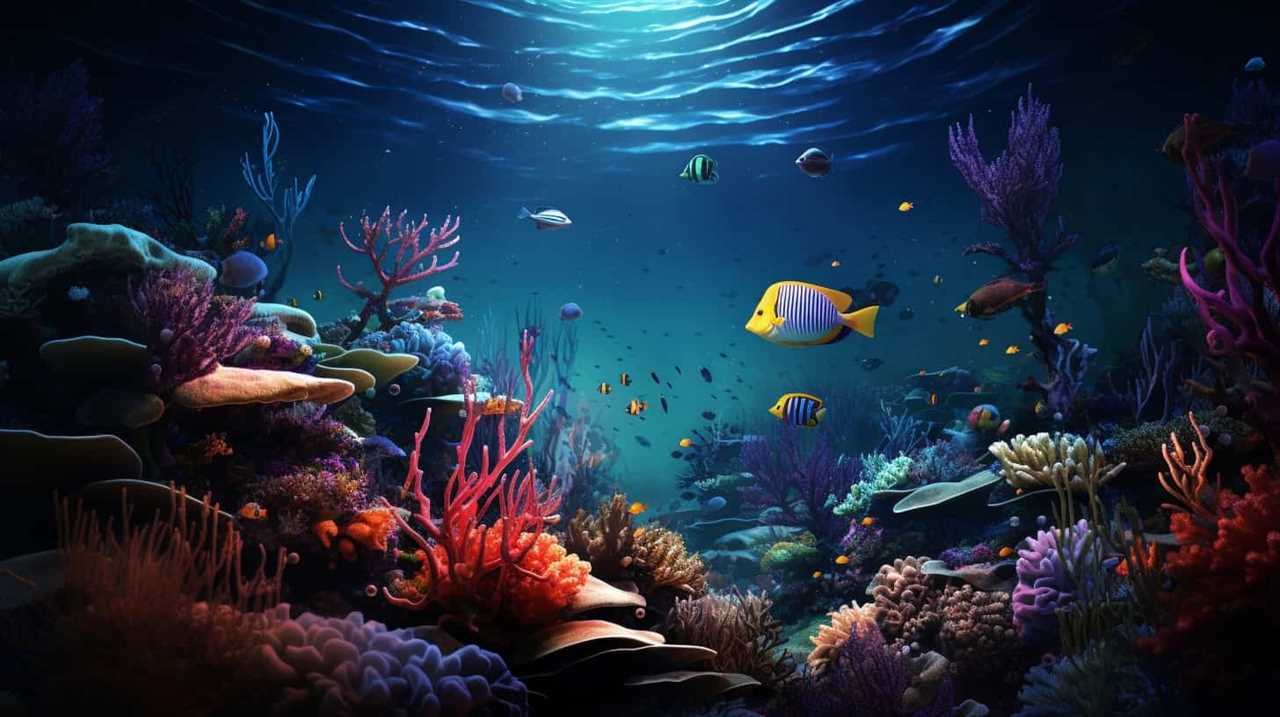We have delved into the intriguing field of underwater acoustics and discovered a mesmerizing world.
Did you know that the sounds in our oceans hold a profound impact on marine life? From the intricate communication methods of aquatic species to the crucial role of underwater acoustics in conservation, we’ve unraveled the secrets of this hidden realm.
Join us as we explore the top insights and future applications of underwater sound technology.
Prepare to dive into a world of fascinating discoveries.

Key Takeaways
- Underwater acoustics is essential for studying and monitoring aquatic life.
- Underwater noise pollution can have detrimental effects on marine mammals.
- Aquatic species communicate through vocalizations, visual signals, and chemical communication.
- Underwater acoustics plays a crucial role in conservation and the protection of marine life.
The Importance of Underwater Acoustics
In our exploration of underwater acoustics, we’ve come to understand the significant role it plays in studying and monitoring aquatic life.
Underwater noise pollution has become a growing concern, as it can have detrimental effects on marine organisms.
By using bioacoustics research, we’re able to investigate the impacts of these noises on various species and ecosystems.
This field of study allows us to measure and analyze the sounds produced by marine life, as well as the noises generated by human activities such as shipping, construction, and seismic exploration.

Understanding underwater acoustics helps us to identify potential threats to aquatic organisms and develop strategies to mitigate them.
With the mastery of this knowledge, we can protect and preserve the delicate balance of our underwater world.
How Underwater Sounds Impact Marine Life
By examining the effects of underwater sounds on marine life, we can further our understanding of the potential impacts of noise pollution on aquatic organisms and ecosystems.
Underwater noise pollution, caused by human activities such as shipping, naval operations, and offshore construction, has been shown to have significant effects on marine mammals. These animals rely heavily on their acoustic environment for communication, foraging, and navigation.

High levels of underwater noise can disrupt their ability to communicate, locate prey, and avoid predators, leading to detrimental effects on their survival and reproductive success. Additionally, chronic exposure to noise pollution can cause physiological stress, hearing loss, and behavioral changes in marine mammals.
Understanding the impacts of underwater sounds on marine life is crucial for implementing effective conservation strategies and mitigating the negative effects of noise pollution on these vulnerable species.
Transitioning to the subsequent section, let’s now explore the communication methods of aquatic species.
Communication Methods of Aquatic Species
Let’s dive into how aquatic species communicate and share information underwater. Communication in the underwater world is a fascinating phenomenon, shaped by evolutionary adaptations and essential for inter species communication.

Here are three key methods that aquatic species use to communicate:
-
Vocalizations: Many aquatic species rely on vocalizations to communicate with each other. These vocalizations can take the form of clicks, whistles, or songs, and are used for various purposes such as mating calls, territorial defense, or group coordination.
-
Visual signals: Some aquatic species communicate through visual signals, using body movements, color changes, or even bioluminescence. These visual displays help convey information about social status, reproductive readiness, or warning signals.
-
Chemical communication: Aquatic species also use chemical signals to communicate. They release chemical substances called pheromones into the water, which can be detected by other individuals. These chemical signals convey important information about mate selection, territory marking, or predator avoidance.

Understanding the communication methods of aquatic species is crucial for unraveling the complex interactions and dynamics of underwater ecosystems. By studying these evolutionary adaptations and inter species communication, we can gain a deeper appreciation for the intricate web of life beneath the surface.
The Role of Underwater Acoustics in Conservation
We will now delve into the crucial role that underwater acoustics plays in conservation efforts, utilizing its ability to actively monitor and protect aquatic life. Underwater acoustics has become an invaluable tool in studying and understanding the role of marine mammals in marine ecosystems. By using advanced monitoring techniques, scientists are able to gather data on the behavior, distribution, and population dynamics of these important species. This information is crucial for effective conservation strategies and management plans. One of the key monitoring techniques involves the use of underwater acoustic sensors to detect and track marine mammal vocalizations. This allows researchers to identify important habitats, migration routes, and breeding grounds, which are vital for protecting these species. By employing underwater acoustics, we can better understand and safeguard the role of marine mammals in maintaining the health and balance of our oceans.
| Role of Marine Mammals | Monitoring Techniques |
|---|---|
| – Important species in marine ecosystems | – Use of underwater acoustic sensors |
| – Behavior, distribution, and population dynamics | – Detect and track marine mammal vocalizations |
| – Crucial for conservation strategies and management plans | – Identify habitats, migration routes, and breeding grounds |
| – Maintain the health and balance of oceans | – Better understand and safeguard marine mammals |
Future Applications of Underwater Sound Technology
Exploring the future applications of underwater sound technology, we aim to discover innovative ways to enhance our understanding and conservation efforts for aquatic life. Underwater sound innovations have the potential to revolutionize marine research, providing valuable insights into the behavior, distribution, and communication of marine species.
Advancements in marine research can be achieved through the following:

-
Autonomous underwater vehicles (AUVs) equipped with advanced acoustic sensors can collect data on marine ecosystems, allowing for continuous monitoring and analysis of underwater soundscapes.
-
Passive acoustic monitoring (PAM) systems can be deployed to detect and classify marine species based on their unique acoustic signatures, providing a non-invasive method for population assessment and biodiversity studies.
-
Incorporating machine learning algorithms and artificial intelligence (AI) can enhance the processing and analysis of underwater sound data, enabling researchers to extract meaningful patterns and trends from large datasets.
Frequently Asked Questions
How Do Underwater Sounds Affect the Behavior of Marine Animals?
Underwater sounds have a significant impact on the behavior of marine animals. Noise pollution affects the communication, feeding, and mating patterns of marine mammals. Fish behavior is also influenced by underwater sounds, altering their movement and foraging strategies.

What Are the Different Types of Communication Methods Used by Aquatic Species?
Aquatic species communicate through a variety of methods including vocalizations and body language. Vocalizations include clicks, whistles, and songs, while body language involves gestures and postures. These communication methods play a crucial role in their social interactions and survival.
How Does Underwater Noise Pollution Impact the Health of Marine Ecosystems?
Underwater noise pollution negatively impacts marine ecosystems by disrupting communication channels, altering reproductive patterns, and causing stress in aquatic species. This has a significant impact on biodiversity and can lead to long-term ecological consequences.
Can Underwater Acoustics Be Used to Track and Monitor the Migration Patterns of Marine Species?
Underwater acoustics enables us to track and monitor the migration patterns of marine species. By studying underwater sound effects on behavior and aquatic communication methods, we can contribute to marine species conservation while minimizing the risks of underwater sound technology.
What Are Some Potential Risks and Challenges Associated With the Future Applications of Underwater Sound Technology?
Potential risks and challenges associated with the future applications of underwater sound technology include potential disturbance to marine life, interference with natural communication, and the need to develop robust monitoring systems to mitigate negative impacts.

Conclusion
In conclusion, the study of underwater acoustics and its impact on aquatic life is of great importance in understanding and conserving our marine ecosystems.
Through this research, we’ve gained valuable insights into how underwater sounds affect communication and behavior of various species.
With future advancements in underwater sound technology, the possibilities for further exploration and conservation efforts are endless.
Dive into the fascinating world of underwater acoustics, where the symphony of marine life awaits your eager ears.











